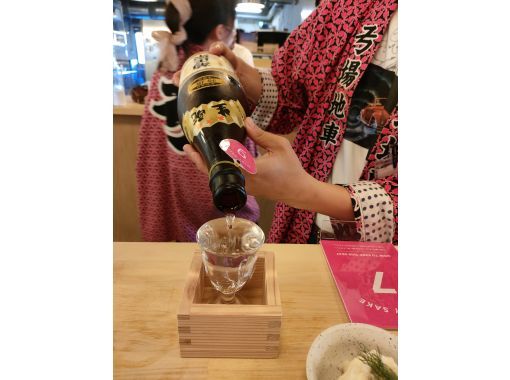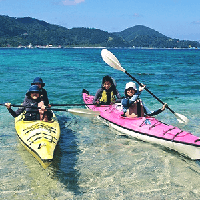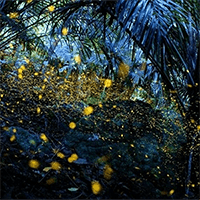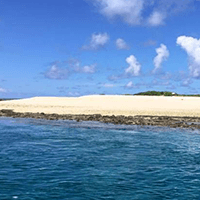Kansai in Sightseeing tour/Guided tour
- Age 6~Age 75
- Within 1 hour
- 10:00 / 11:00 / 12:00 / 13:00 / 14:00 / 15:00 / 16:00 / 17:00 / 18:00 / 19:00
Each kanji character has a meaning, and the appearance of the font is considered beautiful, so ``kanji'' themselves are very popular among foreigners, who often wear T-shirts with large kanji prints on them. Many of you may have seen foreigners with Chinese characters or kanji tattoos on their bodies. The customer chooses such a kanji, and we will explain the calligraphy mindset, tools, and movements, so that they can deeply understand ``Hinomoto Calligraphy'' and write down the kanji they have chosen with a brush.
海外からの友人カップルをつれて体験させていただきました。自分の名前と好きな漢字を習うことができてとても良い旅の経験になりました!次は別の体験も合わせて楽しんでもらおうと思います〜ありがとうございました!
- Age 6~Age 75
- Within 1 hour
- 10:00 / 11:00 / 12:00 / 13:00 / 14:00 / 15:00 / 16:00 / 17:00 / 18:00 / 19:00
The calligraphy of death is something that a samurai writes down with a brush as his last words in this world when he foresees his death. (Death refers to leaving this world) Customers can write their favorite kanji. You can select a character (kanji) and write it with an extra-large brush on SAMURAI paper (16 times the size of normal hanshi), which is made by combining two sheets of hanshi paper that is 8 times the size of normal hanshi paper. (Example) Yukimura Sanada's death note, ``If you go to live in an indefinite floating world, you will not know what will happen one day later.'' (In such an unstable world, we do not know what will happen tomorrow. Please think of Naniwa as something that doesn't exist in this world.'' Toyotomi Hideyoshi's deathbed writings, ``The dew falls, the dew falls and disappears.'' I wonder if Naniwa is also a dream within a dream (I became a citizen, but the dew fell and disappeared.) It was a life that seemed to disappear.)
外国のお友達をつれて一緒に参加させて頂きました。 珍しくて楽しい経験ができてとても喜んでおりました。 先生方もとてもポジティブにご指導して下さり本当に楽しかったです。 ありがとうございました。
- Age 14~Age 99
- 5~6 hours
- 10:00 / 10:30 / 11:00 / 11:30 / 12:00 / 12:30 / 13:00 / 13:30 / 14:00 / 14:30
Walk around Uji, the ancient capital of Kyoto, in a kimono. Feel free to wear a kimono and go out to tourist spots such as long-established tea shops, the Phoenix Hall of Byodo-in Temple, a World Heritage Site (World Cultural Heritage Site), and Ujikami Shrine. You are sure to find a kimono design that suits your taste. You can choose from a wide variety of new and beautiful kimonos and cute yukatas, all available for rental at a low price starting from 3,990 yen (tax included). For a limited time, we also offer a student discount plan. Our experienced dressing staff will consult with you on casual kimonos, yukatas, and popular antique kimonos. Find a kimono that suits you and enjoy a stroll around Uji with friends, parents and children, or as a couple.
- Age 7~Age 100
- 1~2 hours /2~3 hours
- 10:00 / 13:30 / 15:30
This is an approximately 1.5 hour plan where you will experience weaving a 10cm square silk fabric and tour the workshop. You can take your completed work home on the day. Everyone from elementary school students to the elderly can easily weave. Please feel the "texture" of the fabric you have woven yourself. You can see and touch some of Japan's finest works of art, which are world-class, and have a valuable experience learning about their history. *Bonus: Take photos on a restored high aircraft. An original postcard will be presented. You can also go shopping. We have three looms available for the weaving experience. For groups of 4 or more, orders will be given.
初めての機織り体験でした。なかなか機織りが出来る所は少ないのでオススメです。好きな色の糸を選ぶことが出来ました。他にも体験だけでなく歴史や京都の職人さんのお話などとても興味深いお話もして下さいました。英語で説明もあるので外国人の方も来られていました。
- Age 6~Age 70
- 2~3 hours
- 11:00 / 14:00 / 17:00 / 20:00
Let's learn the bushido and experience the samurai spirit.What is the most important thing for a samurai? Wearing hakama, sandals, and a sword, and learning etiquette, manners, and kata. We call it the BUSHIDO sign.Next, as a BUSHIDO LEARN, you will experience the weight and sharpness of a real Japanese sword. We will learn the basics of swordsmanship (Battou and Nattou).We will take a break with SAMURAI TEA on the way. You will be entertained at a tea ceremony, as samurai risked their lives to "entertain" and "be entertained".Before participating in the final battle of the Warring States Period, the Battle of Osaka, the participants are asked to prepare for death and reflect on their own lives, writing their last words with a large brush on every piece of paper. This is called Deathbed calligraphy.At last, he puts on his armor and helmet to become a bushido master and goes to battle at the castle of Osaka to gain military merit in the battle of Osaka. However, when the defeat was imminent, the samurai, for the sake of honor, would not suffer the shame of the noose, even if they lost the battle, but would die by harakiri or cutting their belly before being captured.
- Age 6~Age 70
- 1~2 hours
- 11:00 / 14:00 / 17:00 / 20:00
Osaka no Jin ⚔ Pilgrimage to sacred places refers to the stages of battles such as the 1614 (Keicho 19) battle "Osaka Winter Jin" and the 1615 (Genna 1) restarted battle "Osaka Summer Jin" and other battles. It is to visit places connected to Osaka Castle as sacred places with “SAMURAI STYLE”. In addition, the term ``Japan's best soldier, who acted with great courage and speed'' in that battle was a name used to praise Sanada Nobushige (Yukimura), who was loyal to his lord, did not betray him even with money or territory, and was close to Tokugawa Ieyasu during the Summer Siege in Osaka. . Yukimura Sanada shined dazzlingly as a Sengoku military commander in the battle that concluded the Sengoku period. His vivid life still fascinates many people today, and let's make a pilgrimage to the sacred place of his glorious battle at Osaka, where he was praised as ``the greatest soldier in Japan.''
- Age 6~Age 70
- 1~2 hours
- 11:00 / 14:00 / 17:00 / 20:00
Osaka no Jin ⚔ Pilgrimage to sacred places refers to the stages of battles such as the 1614 (Keicho 19) battle "Osaka Winter Jin" and the 1615 (Genna 1) restarted battle "Osaka Summer Jin" and other battles. It is to visit places connected to Osaka Castle as sacred places with “SAMURAI STYLE”. In addition, the term ``Japan's best soldier, who acted with great courage and speed'' in that battle was a name used to praise Sanada Nobushige (Yukimura), who was loyal to his lord, did not betray him even with money or territory, and was close to Tokugawa Ieyasu during the Summer Siege in Osaka. . Yukimura Sanada shined dazzlingly as a Sengoku military commander in the battle that concluded the Sengoku period. His vivid life still fascinates many people today, and let's make a pilgrimage to the sacred place of his glorious battle at Osaka, where he was praised as ``the greatest soldier in Japan.''
- Age 6~Age 70
- 1~2 hours
- 11:00 / 14:00 / 17:00 / 20:00
This is a plan to commemorate and make a pilgrimage to the sad sacred place where SAMURAI and his friends were defeated in the Osaka Siege in the last war and fell to the castle, wearing armor and helmets reminiscent of the battle. ~ A famous castle that records the history of prosperity and turmoil of the people of Japan ~ This is how Osaka Castle is introduced on its official website. However, there was no trace of Osaka Castle, which boasted of being impregnable, as all of the moats other than the main castle and the moat that had been dug back during the peace of Ieyasu's plot at the Osaka Siege were filled in. The Tokugawa army destroyed the Sanada army and invaded the castle one after another, led by the Echizen army led by Matsudaira Tadanao, who was the first to arrive.The fire set by a Tokugawa army informer in the main castle kitchen quickly destroyed the castle tower. Osaka Castle finally fell at midnight on the 7th. When Hinomoto's greatest soldier, Nobushige, was a hostage of the Toyotomi family, he was liked by Toyotomi Hideyoshi, so he was treated more like a vassal than a hostage. The reason Yukimura sided with Toyotomi, who was at an overwhelming disadvantage at the Battle of Osaka, was to protect his loyalty to Hideyoshi. ``This Yukimura was summoned to a place where he was simply trying to prolong his life, and he was given honor as a samurai. This kindness cannot be replaced by land or money. ''When Ieyasu tried to persuade him to defect, he said, ``I have no intention of defecting even if I receive half of Japan.'' ``If you forget your debts and indulge in self-interest, can you call yourself a human being?'' he left behind the words of Hinomoto's greatest soldier.
- Age 6~Age 70
- 1~2 hours
- 11:00 / 14:00 / 17:00 / 20:00
Let's learn the bushido and experience the samurai spirit.What is the most important thing for a samurai? Wearing hakama, sandals, and a sword, and learning etiquette, manners, and kata. We call it the BUSHIDO sign.Next, as a BUSHIDO LEARN, you will experience the weight and sharpness of a real Japanese sword. We will learn the basics of swordsmanship (Battou and Nattou).We will take a break with SAMURAI TEA on the way. You will be entertained at a tea ceremony, as samurai risked their lives to "entertain" and "be entertained".Before participating in the final battle of the Warring States Period, the Battle of Osaka, the participants are asked to prepare for death and reflect on their own lives, writing their last words with a large brush on every piece of paper. This is called Deathbed calligraphy.At last, he puts on his armor and helmet to become a bushido master and goes to battle at the castle of Osaka to gain military merit in the battle of Osaka. However, when the defeat was imminent, the samurai, for the sake of honor, would not suffer the shame of the noose, even if they lost the battle, but would die by harakiri or cutting their belly before being captured.
- Age 20~Age 99
- 3~4 hours
- 13:00
Nadagogo, Japan's number one sake brewery, is a mecca for sake lovers, where you can enjoy free tours and tastings of more than 10 sake breweries. Sake breweries gather along the Hanshin Railway lines, and the roads are flat, making it perfect for walking around town.If you come to Kansai, please try it once. Sake made from high-quality sake rice (Yamada Nishiki) suitable for sake brewing and high-quality underground water rich in minerals. This is a tour around Nada, which has prospered as a famous sake production area since the Edo period because of its port.・A walking tour of Japan's No. 1 sake brewery, Nada Sake Brewery・Please try this tour where you can learn trivia, history, manufacturing process and more.・10 free tastings included, so be careful not to drink too much.
- Age 13~Age 65
- 5~6 hours
- 09:30
This tour is an adventure tour that combines the mysterious world of Shugendo with the thrill of cave exploration. There are many caves and waterfalls in the Yoshino region of Nara Prefecture, and it has long been considered a sacred place for people who practice asceticism in the mountains. You can experience the beauty of nature and the depth of history by visiting the waterfalls and caves where ancient ascetics practiced. In particular, by exploring inside a cave, you can experience the sensation of entering the womb of the earth with all five senses, touch the mysteries of nature, and refresh your mind and body while being surrounded by a ``silent and mysterious'' atmosphere. **What is Shugendo? **Shugendo is a unique religious culture that incorporates elements of Buddhism and Shintoism into traditional Japanese ascetic practices, and values a sense of unity with nature. Mountains are considered sacred places, and asceticism is carried out in nature. Ascetics are called ``Yamabushi'' and aim for spiritual growth through meditation, waterfall training (asceticism where you are hit by a waterfall), asceticism in caves, etc. Shugendo, born from gratitude for being alive amidst the blessings of nature, is based on the idea that one can be reborn once again through rigorous training in nature. Caves have also been used as training sites. 1. **Arrival at Yoiyoi Nishikawa Base and Briefing**: - After arriving at Yoiyoi Nishikawa Base, you will receive a briefing on the tour overview, safety, and the cultural significance of the places you will visit. 2. **Introduction to Dragonfly Falls Hike**: - Visit Dragonfly Falls, which was also a training site for Shugendo, located a one-minute drive from Yoiyoi Nishikawa Base. Here, you will experience the training of Shugendo and how to face nature, including waterfalls. 3. **Lunch Break**: Have lunch at the park below Dragonfly Falls 4. **Preparing for Expedition**: - Return to Yoiyoi Nishikawa Base and prepare your exploration gear. Once you are ready, you will drive in your guide's car for about 15 minutes to the parking lot near the cave. 5. **Start of cave exploration**: - After arriving at the parking lot, the cave exploration will begin. The exploration begins by searching for the entrance of the cave. Please discover the cave with your own hands. In order to enjoy the cave exploration empty-handed, your luggage will be left in the car and your guide will take care of your valuables other than your smartphone. 6. **Cave exploration**:7. **Response after cave exploration**: - Return to the same parking lot and change from your dirty equipment. 8. **Hot spring bath**: - After the cave exploration, you can enjoy a hot spring bath. We will provide face towels. Please spend some time relaxing and soothing your tired body in the hot spring. 9. **Pick-up and disbandment**:
- Age 1~Age 5
- 1~2 hours
- 10:00 / 13:30 / 15:30
[Parent-child weaving experience * For preschoolers] It is a plan of about one and a half hours to experience weaving 10 cm square silk fabric and to tour the workshop. The finished work is On the day you can take home. You can easily weave with preschoolers. Feel the "texture" of the woven fabric you woven yourself. You can see, touch, and experience the world's best works of art in Japan. * Bonus: Take a photo on a restored high-end machine. Present an original postcard. You can also shop. We have two weaving machines for you to experience weaving. ◆ Workshop tour ◆ (Approximately one to one and a half hours) In the workshop tour, you can see the Nishikiori workshop of textile artist Koho Tatsumura and the Hand-making site that inherits traditional textiles. You can see Nishikori works, restored textiles, restored high machines, textile materials, etc. with explanations. Choose one from about eight types of colored threads (weft threads), weave a silk fabric of about 10 cm square with a traditional weaving machine, and take it home. ◆ Weaving experience ◆ (Weaving time is about 20 minutes, processing by staff is 10 minutes) This is an experience of weaving a silk fabric of about 10 cm square with a traditional weaving machine by selecting one from about 8 types of colored threads (weft threads). You can take what you have made with you. [Target] Preschoolers [Experience fee] 2,500 yen (tax included) / 1 preschooler's child and 1 guardian One additional guardian is a tour fee / 700 yen (Reference: Student 500 yen (Free for elementary school students and less) (A separate experience fee is required if an attendant is to experience it. It will be smooth if you make a reservation from our other weaving experience plans.) [Time required] Workshop tour + weaving experience Approximately 90 minutes (weaving time approximately 20 minutes) [Conditions] 〇 Parents can weave together with support. Assistance is required because there are tasks such as stepping on the treads with your feet and being out of reach. [Caution] 〇The experience is for one person. Please refrain from weaving by multiple people in one experience. It is not possible to weave in turns. [Experience flow] (Example) Workshop tour ⇒ Weaving experience ⇒ Workshop tour [Bonus] ① Take a photo on a weaving machine that has been restored from an ancient high machine. (2) One original postcard will be presented to each person.
とても高技術の伝統文化を少しでも知る事が出来る上に、楽しみながら手、足を使い編み込んでいく作業は脳にも良い作業だと思います。 最後にバックのポケットとして貼り付けて持ち帰らせて頂く、、このお洒落な完成の発想に子供達は大喜びでした。
- Age 7~Age 90
- 2~3 hours
At Mitsuishi Fudoson, a traditional esoteric Buddhist temple that worships the waterfall where Kobo Daishi trained at the age of 21, we will practice rituals at the goma and make our wishes come true. The prayer priest is Sato Myosen (representative of the Kishu Koyasan Yokofue Association), a nun who lives in Mt. Koya. After the Goma prayer, if the weather is good, you can visit the waterfall and achieve a unique purification. Although you can apply for the Goma prayer experience alone, we recommend visiting in a group.
最近チェックしたプラン
Please wait a moment
![[By Osaka Castle] Learning Zen of Japanese Beauty Calligraphy in kimonoの画像](https://img.activityjapan.com/10/52954/10000005295401_0NLp2Urf_3.jpeg?version=1735455605)
![[Osaka castle] Learning Bushido & Zen at Samurai Calligraphy in kimonoの画像](https://img.activityjapan.com/10/52953/10000005295301_0NLp2Urf_3.jpg?version=1735455906)
![[Kyoto, Uji] Kimono and yukata complete rental plan Popular lace kimono and pure silk kimono available♪ Near long-established Uji matcha sweets shop and Tale of Genji Museumの画像](https://img.activityjapan.com/10/55308/10000005530801_eomBAEMI_3.jpeg?version=1723361466)
![[Kyoto / Kita Ward] Weaving experience (plain weaving / hand weaving) & workshop tour / Experience the best Nishiki traditional fabrics, art and historyの画像](https://img.activityjapan.com/10/14026/10000001402601_IpdJM0ZF_3.jpg?version=1679460662)
![[OsakaCastle] Hands-on class to learn Bushido/Harakiri & Zen with photoの画像](https://img.activityjapan.com/10/52660/10000005266001_lpXgdgDW_3.jpg?version=1735456203)
![[Osaka/Tamatsukuri] Osaka no Jin "Hinomoto's No. 1 Soldier" pilgrimage tour guide (Tamatsukuri area)の画像](https://img.activityjapan.com/10/52625/10000005262501_xEnFGyJR_3.jpg?version=1706264164)
![[Osaka/Tennoji] Osaka no Jin "Hinomoto's No. 1 Soldier" pilgrimage tour guide (Tennoji area)の画像](https://img.activityjapan.com/10/52569/10000005256901_xEnFGyJR_3.jpg?version=1706258885)
![[Osaka/Osaka Castle] Pilgrimage tour guide to the sacred sites of famous castles that mark the history of prosperity and turmoil among the people of Japan (Osaka Castle area)の画像](https://img.activityjapan.com/10/52567/10000005256701_xEnFGyJR_3.jpg?version=1735524365)
![[By Osaka Castle] Hands-on class to learn Bushido & Zen with photoの画像](https://img.activityjapan.com/10/52543/10000005254301_yvTwbz4o_3.jpg?version=1735524126)

![[Nara, Yoshino] Cave Adventures: Discover the Mystical Paths of Shugenの画像](https://img.activityjapan.com/10/56866/10000005686601_8OUZBun9_3.JPG?version=1733231762)
![[Kyoto * For preschoolers] Parent-child weaving (hand-weaving) experience & workshop tour-Experience the highest peak of Nishiki traditional textiles, fine arts and historyの画像](https://img.activityjapan.com/10/35588/10000003558801_DxHr56K4_3.jpg?version=1679461262)
![[Wakayama/Hashimoto] Goma prayer experience to fulfill your wishes by a Shingon practitionerの画像](https://img.activityjapan.com/10/50507/10000005050701_QTRiVNk2_3.jpg?version=1693699145)







